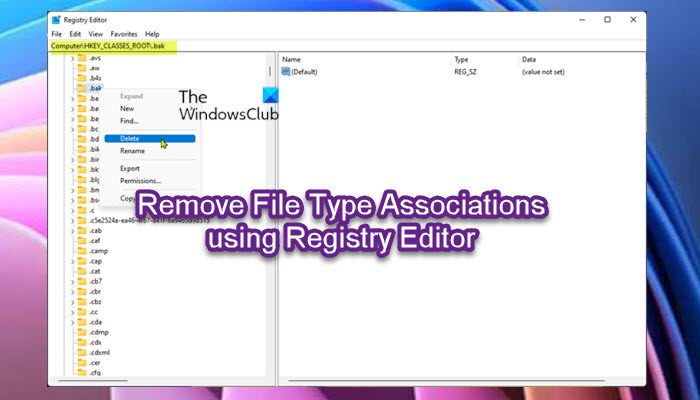In Windows 11 or Windows 10, you can Configure, Export, Import File Associations and even set or change file associations and extensions using GUI, but there is no option provided to delete an existing file type association. In this post, we will walk you through the steps on how to remove File Type Associations using Registry Editor.

What is File Type Association?
Basically, a file association associates a file with a specific application that is able to open the file. Similarly, a file type association associates a type of file (eg the .docx file) with a corresponding application (Microsoft Word). A single file extension might have more than one association for performing different actions – an application might be associated with a file extension to open a specific type of file, but another program might also be associated to open and edit the files.
Remove File Type Associations using Registry Editor
Associating a file type with a program can be done in several ways, such as using the Open with dialog and selecting the Always use this app to open checkbox, or via Default Programs or Default Apps. File type association is very helpful, but it might get corrupted, which can cause a file to be opened with another application that may not be suitable. In this case, you should remove file type associations for the file to stop opening the file with the associated app by default.
For the purposes of this post, let’s assume you’ve incorrectly associated a file type named .bak, you can easily reset all Apps and File Associations to default in Windows 11/10. But, if you want to remove the association instead, you can perform the task using the registry by following our instructions below. In the case where all the file extensions have changed to some unknown file format, this could help!
Since this is a registry operation, it is recommended that you back up the registry or create a system restore point as necessary precautionary measures. Once done, you can proceed as follows:
- Press Windows key + R to invoke the Run dialog.
- In the Run dialog box, type regedit and hit Enter to open Registry Editor.
- Navigate or jump to the registry key path below:
HKEY_CLASSES_ROOT\.bak
- At the location on the right pane, make a note of the (default) value data. It’s the ProgID associated with that file type.
- Now, right-click the key .bak and choose Delete.
- Click Yes on the prompt to confirm.
- Next, go to the following HKEY_CURRENT_USER keys and delete the .bak key as well.
HKEY_CURRENT_USER\SOFTWARE\Microsoft\Windows\CurrentVersion\Explorer\FileExts\.bak
HKEY_CURRENT_USER\SOFTWARE\Microsoft\Windows\Roaming\OpenWith\FileExts\.bak
- Exit Registry Editor when done.
- Restart PC.
The file association settings for .bak file type should now be removed on your computer, and the deleted file type will be set as unknown by Windows.
This is how you can remove File Type Associations using Registry Editor in Windows 11/10.
Related post: How to use Unassociate File Types remove File Type associations.
How do I remove default program from file type?
To remove default program from file type in Windows 11/10, do the following:
- Click on Start and then Control Panel.
- Click on the Programs link.
- Click on the Make a file type always open in a specific program link under the Default Programs heading.
- In the Set Associations window, scroll down the list until you see the file extension that you want to change the default program for.
How do I reset the default associations in Windows 10?
To reset all Apps and File Associations to default in Windows 11/10, do the following:
- Press Win+I to open Windows Settings.
- Go to Apps > Default apps.
- Scroll down to the bottom.
- Click on the Reset button.
- Click the OK button.
Read: What is a BAK file and how do I open it?
Where are file type associations stored in the registry?
File associations are stored in both HKLM\SOFTWARE\Classes and HKCU\SOFTWARE\Classes; you can see a merged view of the data under HKEY_CLASSES_ROOT hive. Similarly, you can identify the application that is associated with a given file by right-clicking the file in File Explorer and then clicking Properties.
Leave a Reply